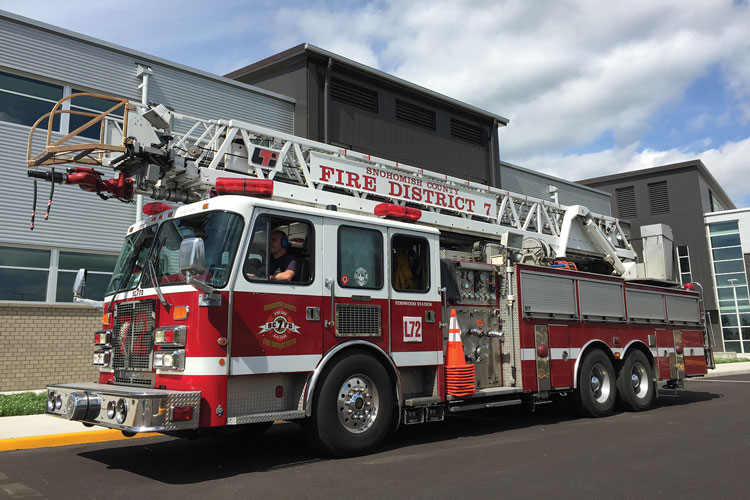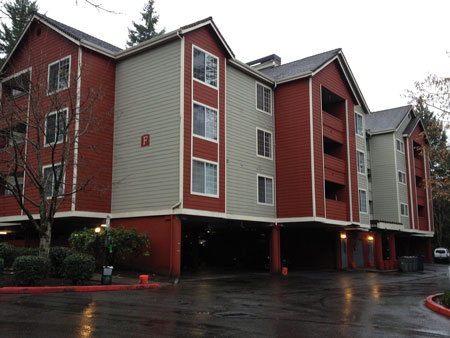
By Rob Fisher
Many fire departments these days are purchasing ladder trucks with some form of fire suppression capability such as the quint. The quint ladder truck is joining the apparatus ranks alongside the traditional ladder truck, tower, or tractor-drawn aerial (TDA). The quint departs from the traditional engine vs. truck operations model presented in most fireground tactics manuals and department standard operating guidelines (SOGs) adopted over decades. So, the need for planning your desired fire apparatus positioning on the fireground is greater than ever before (photo 1).
The quint ladder truck offers fireground multifunctionality. But, its ability to perform multiple functions is most often limited by the available resources, the aerial length, the building offset, the hosebed’s design/deployment, staffing, and so forth. Overlooking these factors can negatively impact the fireground. Two o’clock in the morning with an advanced fire and victims is not the time to start figuring it all out.
Four Initial Fireground Needs
The fireground is a form of “controlled chaos”; the difference between chaos and controlled chaos centers around four initial fireground needs. If responding apparatus can fulfill these initial fireground needs, the fireground incident commander (IC) will have a good foundation on which to develop a clear strategy that is supported by good tactical objectives.
- All dispatched fire apparatus arrive safely. A ton of preplanning goes into selecting the types of apparatus that should respond to a given incident. For the most efficient operations at an incident, all personnel and apparatus must arrive safely to the scene.
- A good initial size-up on arrival. The first-arriving officer’s ability to assess the incident situation will enable developing a proper strategy and setting tactical priorities.
- Good communications. After completing a good size-up, communicate this information for everyone to hear to ensure everyone knows your plan.
- Place fire apparatus properly to meet the incident’s current and future needs. If you need a specific type of apparatus or if the incident’s anticipated needs will require using certain apparatus (e.g., a ladder truck), leave space on the scene for that apparatus to properly position and operate. This allows the greatest opportunity for the most effective use of its capabilities.
Initial vs. Future Positioning
Traditionally, for a working fire in a multifamily dwelling, most fireground tactics manuals recommend spotting the first-due engine so as to give the first-arriving ladder company the most optimal position at the fire building. This allows the ladder company the best opportunity to reach the building for rescue and to access the roof for ventilation. The engine apparatus can concede the most optimal spot in front of the building to the ladder truck because the engine carries several hundred feet of attack and working line. The quint often has limited hose storage, which makes it difficult to position in a similar fashion if another ladder company is following behind it.
Battalion Chief James Silvernail from the Metro West (MO) Fire Protection District discussed the importance for suburban departments (or departments with similar deployment models) to develop SOGs focused more on the incident’s needs than on the designed function of the responding apparatus – e.g., ladder truck, quint. In “Suburban Fire Tactics: Developing Functional SOGs” (Fire Engineering, April 2016) he makes several great points on developing a game plan for a fire in a garden-style apartment using the “One-Plus-One” concept. Essentially, this involves piggybacking companies to properly place a hoseline into operation while accomplishing some interior fireground support functions (e.g., forcible entry and search). Together, these companies fulfill traditional engine company (fire attack) and truck company (fireground support) functions.
 |
| Photos by author. |
I agree with much of what Silvernail says regarding addressing the tactical priorities. I would add that fireground SOGs should outline expectations and the desired quint apparatus position for some specific occupancies. Functioning as an engine on a single- or two-story residential structure is reasonable. The need for an aerial is unlikely, and ground ladders are very effective on these structures. This could also be true for single-story strip malls. The rear (Charlie side) of the building is the preferred position for ground ladder access to the roof, since the front can be difficult to access with any type of ladder if the structure has a decorative façade.
Now, this becomes a more complicated issue when the quint arrives first due at an apartment building with an advanced fire condition and victims or at a large commercial building on fire. The problem is complicated even more when there is not another ladder on the alarm or its arrival is not within an acceptable timeframe to be effective or have access to operate (photo 2).
Hose Stretch or Aerial Ops?
Should the quint position for aerial operations or attempt to make the stretch on these larger occupancy types? If the quint positions for the hose stretch, it is most likely out of position for aerial operations. This can prove to be problematic if there are victims requiring rescue on upper floors or if the fire is running through the attic, plenum space, or cockloft.
Conversely, if the quint positions for aerial operations, it will likely not be close enough to make the stretch to the fire. The argument is that the multifunctionality of a quint should allow this apparatus to do both. Even if a department had the staffing to do both functions simultaneously, in most cases, apparatus positioning would not afford the ability to make it happen. Preplanning and developing strong fireground SOGs that address quint fireground operations can help them function responsibly.
The first-arriving officer on a quint must decide in a few crucial moments if the apparatus should position to function as an engine and attack the fire or spot as a truck and support the overall tactical priorities of the fireground. This can be one of the most difficult decisions if it is not predetermined or thought out prior to responding to a working fire. Apparatus positioning on the fireground can make or break a progressing incident. It is the one thing that is nearly impossible to fix if it is not done correctly from the beginning.
To achieve proper fire apparatus placement at any incident, you must first consider these important factors: apparatus type (i.e., its functional responsibility); occupancy; fire location; visible/known victims; responding resources; and the future needs of the incident (i.e., defensive fire conditions).
Recommended Quint Fireground SOGs
Following are recommendations for quint fireground positioning SOGs:
- Position the quint on the fireground to maximize the use of the aerial device. The occupancy’s size and the fire location will help to determine its functional responsibility as an engine or as a truck.
- The quint’s aerial device may be used to rescue known entrapped victims. Position the aerial to maximize the scrub area.
- The officer is responsible to prioritize the quint’s use for rescue, firefighter access, ventilation, and elevated master stream operations.
- Should the quint arrive first due on a structure fire, it should position and prepare to fulfill fireground support functions – e.g., search, ventilation, providing a second means of egress, utilities, and so forth.
- At the officer’s discretion, the quint may initiate a fire attack using tank water or the CAFS to support a known rescue or to alter marginal fire conditions. In this case, the officer shall clearly communicate the quint’s actions to the remaining responding units. Additionally, the first-due engine shall be responsible on arrival to take over fire attack and set up as the primary fire attack so the ladder company can support the fire attack by completing the remaining fireground support functions.
- If there is an unreasonable delay in the arrival of the first-due engine, the quint may be required to initiate fire attack with a water supply. In this case, the officer or the responding battalion chief shall request adding an additional ladder company to the alarm.
- Once the first-due engine arrives, it shall be at the IC’s discretion to continue using the quint as the primary fire attack unit or to reassign it to facilitate necessary fireground support functions.
- If the IC has decided to use the quint for fire attack, the IC will be responsible to verify that an additional ladder company was added to the alarm. The second ladder company shall facilitate the necessary fireground support functions to support the fire attack or assist units already fulfilling this responsibility.
Having a quint arrive first or second due at a working fire can be a challenge depending on your department’s resources, since this apparatus has the versatility to function as an engine or a ladder truck. Many argue this is an advantage and not a disadvantage. There are advantages to having a quint if the department has properly planned for such a scenario. However, in my experience, the greater majority have not prepared their officers for success through training and preplanning. Commonly, the approach has been to figure it out when they get there because the fireground is a dynamic environment.

Develop SOGs that outline what you expect of the quint on the fireground, especially for certain occupancies. After developing your fireground SOGs, provide tabletop training for your department officers, specifically those working on the quint. Talking about it in the classroom is a good start, but it really needs to be reinforced on the training ground. We must position apparatus to take full advantage of their functional responsibilities.
If you have the chance to design a new quint or modify a current one, consider large static hose beds (longer than 300 feet) or predetermined progressive hose loads – i.e., 2½-inch reduced to 1¾-inch attack bundles. A hose deployment model similar to this could address the problem of positioning as a ladder truck and functioning as an engine. Unfortunately, having 150- or 200-foot preconnects might not be enough for the larger occupancies.
Finally, make sure those assigned to the quint are good at truck work – the fireground support functions. Quint personnel should think truck functions first and engine functions second since the quint might be the only ladder company on the alarm.
ROB FISHER, a 28-year veteran of the fire service, is a captain with Snohomish County (WA) Fire District #7, assigned to the training division. He is a member of the Puget Sound F.O.O.L.S. and is the current F.O.O.L.S. International educational trustee. Fisher received the 2008 Dana Hannon Award for training. He has an associate degree in fire command administration and a bachelor’s degree in public safety and emergency management. Fisher teaches ladder company and quint operations courses for organizations at the Washington State Fire Academy as a recruit academy instructor.
The 75-Foot Quint : Know What It Can Do
TO BUY (OR NOT TO BUY) A QUINT
Quint Apparatus
Fire Engineering Archives

